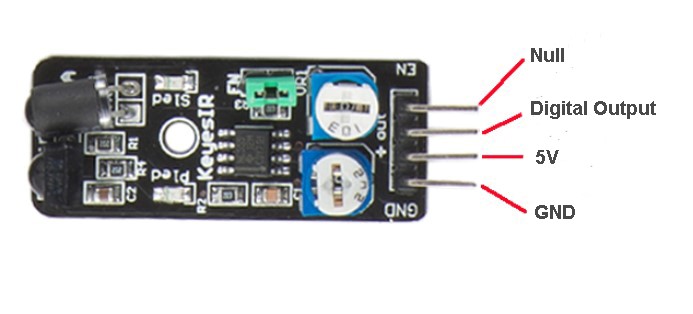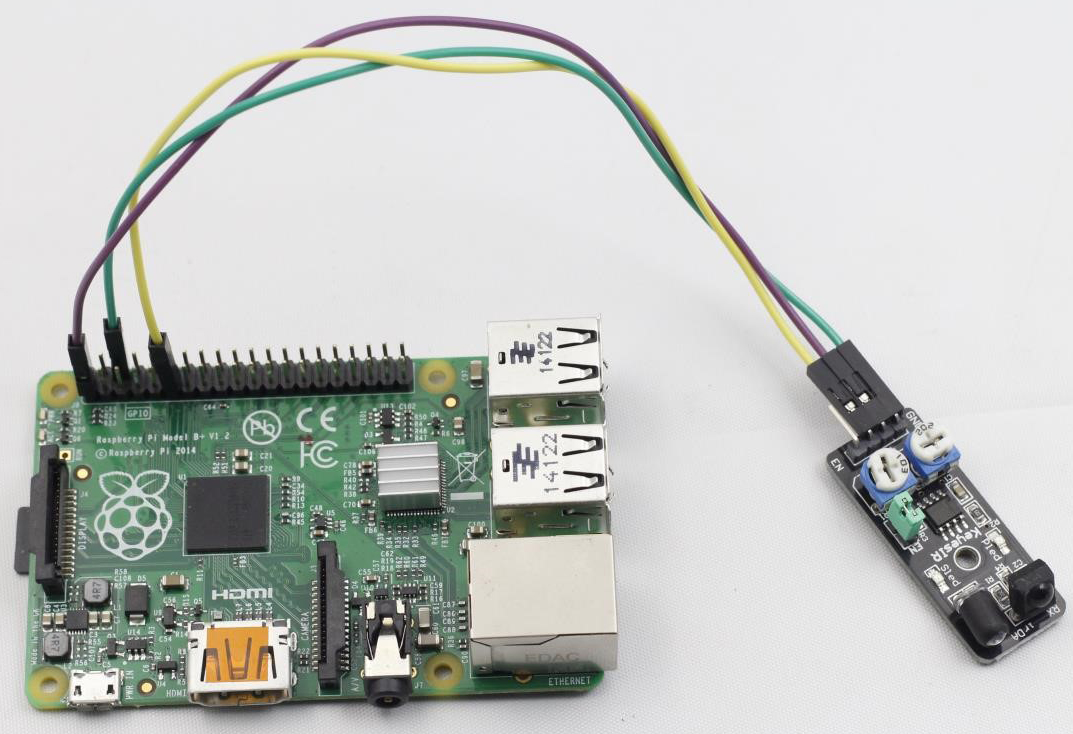Introduction
An obstacle avoidance module (as shown below) uses infrared reflection principle to detect obstacles. When there is no object ahead, infrared-receiver cannot receive signals; when there is an obstacle in front, it will block and reflect the infrared light, and then the infrared-receiver can receive related signals.

Components
– 1 * Raspberry Pi
– 1 * Network cable (or USB wireless network adapter)
– 1 * Obstacle Avoidance Sensor module
– Several jumper wires
Experimental Principle
An obstacle avoidance sensor mainly consists of an infrared-transmitter, an infrared-receiver and a potentiometer. According to the reflecting character of an object, if there is no obstacle, emitted infrared ray will weaken with the transmisasion distance and finally disappear. If there is an obstacle, when the infrared ray encounters it, the ray will be reflected back to the infrared-receiver. Then the infrared-receiver detects this signal and confirms an obstacle existing in front.
Note: The detection distance of the infrared sensor is adjustable – you may adjust it by the potentiometer on the module.
Experimental Procedures
Step 1: Build the circuit
Raspberry Pi Obstacle Avoidance Sensor
GPIO0 ————————————– OUT
3.3V —————————————- +
GND —————————————- GND
Step 2: Edit and save the code (see path/Rpi_SensorKit_code/21_obstacleAvoidence/obstacle.c)
Step 3: Compile
gcc obstacle.c -lwiringPi
Step 4: Run
./a.out
Now, put an obstacle in front of the module, and a string “Detected Barrier!” will be printed on the screen.

obstacle.c
#include <wiringPi.h>
#include <stdio.h>
#define ObstaclePin 0
void myISR(void)
{
printf("Detected Barrier !\n");
}
int main(void)
{
if(wiringPiSetup() == -1){ //when initialize wiring failed,print messageto screen
printf("setup wiringPi failed !\n");
return 1;
}
if(wiringPiISR(ObstaclePin, INT_EDGE_FALLING, &myISR) < 0){
printf("Unable to setup ISR !!!\n");
return 1;
}
while(1){
;
}
return 0;
}
Python Code
#!/usr/bin/env python
import RPi.GPIO as GPIO
ObstaclePin = 11
def setup():
GPIO.setmode(GPIO.BOARD) # Numbers GPIOs by physical location
GPIO.setup(ObstaclePin, GPIO.IN, pull_up_down=GPIO.PUD_UP)
def loop():
while True:
if (0 == GPIO.input(ObstaclePin)):
print "Barrier is detected !"
def destroy():
GPIO.cleanup() # Release resource
if __name__ == '__main__': # Program start from here
setup()
try:
loop()
except KeyboardInterrupt: # When 'Ctrl+C' is pressed, the child program destroy() will be executed.
destroy()
